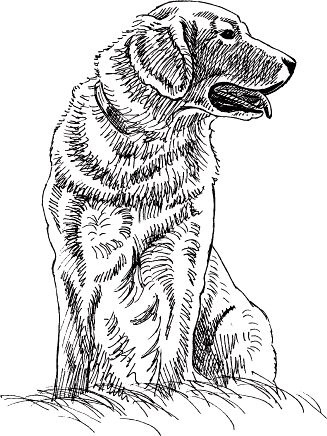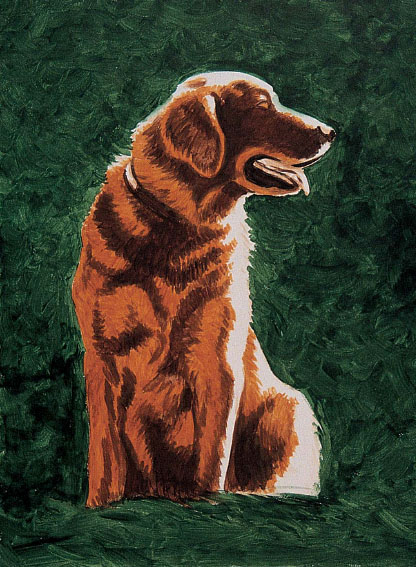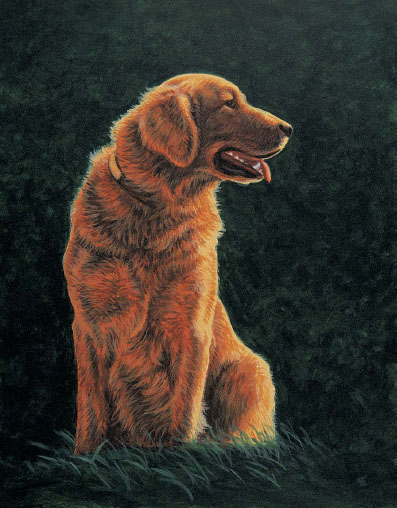Project 8: Golden Retriever
Golden retrievers are a popular breed because they embody what a lot of people think of as the ideal family dog: they are good natured, playful and affectionate. Webster, a dog whose portrait I painted for his owners, was no exception.


Reference Photo
Materials
Paints
Burnt Sienna
Burnt Umber
Cadmium Orange
Hooker’s Green Permanent
Payne’s Gray
Raw Sienna
Scarlet Red
Titanium White
Ultramarine Blue
Viridian
Yellow Oxide
Brushes
no. 1, 3, 4 and 5 rounds
no. 8 shader

1 Establish the Form and the Dark Values
Draw the dog lightly in pencil, using a kneaded eraser to lighten any dark lines or make corrections. Use Burnt Umber thinned with water and a no. 4 round to establish the form.
Mix Burnt Umber and Ultramarine Blue for the black parts of the dog—the nose and jowls. Paint with a no. 3 round. Mix Burnt Umber, Burnt Sienna and Ultramarine Blue for the shadowed parts of the dog’s coat. Paint with a no. 5 round, using strokes that follow the hair pattern. For the darkest shadows, apply more than one coat of paint after the first layer is dry.

2 Paint the Middle Values
Mix the reddish gold color for the retriever’s coat with Raw Sienna and Burnt Sienna. Paint with a no. 4 round. Paint thinly enough so the white panel shows through with strokes that follow the hair pattern.
Imixed the dark green background color with Viridian, Cadmium Orange and Burnt Umber. I used dabbing strokes with a no. 8 shader, switching to a no. 4 round for around the dog’s outline. For the foreground grass, I painted sweeping strokes with the no. 8 shader.

3 Add Lighter Values and Begin the Details
Mix a pinkish shadow color for the tongue with Scarlet Red, Burnt Sienna and a small amount of Ultramarine Blue. Paint with a no. 3 round. For the tongue’s highlight color, mix Titanium White, Scarlet Red and Yellow Oxide. Paint with a no. 3 round.
Mix a highlight color for the dog’s coat with Titanium White and a small amount of Yellow Oxide. Transfer a portion of this color to a dry wax paper palette, then use a no. 3 round to paint.
Transfer a portion of the shadow color from Step 1 to the dry paper. Begin to integrate the dark shadows in the dog’s coat with a no. 3 round, painting strokes in the direction of hair growth. Start your strokes from the shadows and overlap the lighter areas.
I darkened the background by adding another layer of the dark green color using the same brushes.

WEBSTER
Acrylic on Gessobord
10” × 8” (25cm × 20cm)
4 Add the Finishing Details
Mix a golden copper color for integrating the dog’s coat with Titanium White, Raw Sienna, Yellow Oxide and small amounts of Cadmium Orange and Burnt Sienna. With a no. 3 round, paint strokes that follow the hair pattern, from the lighter parts of the coat overlapping the darker areas. For details in the darker parts of the coat, take a portion of this color and add more Cadmium Orange and Burnt Sienna. Use a separate no. 3 round and the shadow color from Step 1 to soften and integrate. Use a no. 3 round and the darker golden copper to add some detail to the highlighted parts of the dog’s coat.
For the bluish areas of the nose and jowls, mix Ultramarine Blue, Burnt Umber and Titanium White. Paint with a no. 1 round.
Use a no. 1 round to mix a small amount of Titanium White with touches of Ultramarine Blue and Burnt Umber, then paint the teeth.
I mixed a portion of the dark green background color with Titanium White and Cadmium Orange. Then I used this color to paint some blades of grass around the dog with a no. 3 round, using sweeping, curved strokes.
